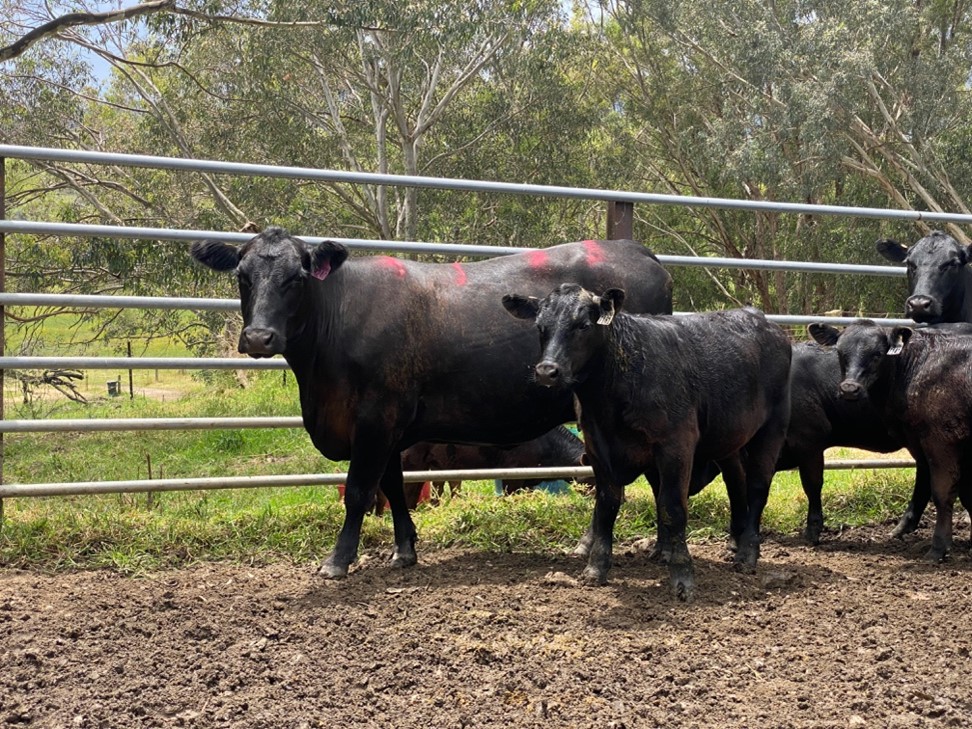Genomics for commercial Angus cattle
09 August 2023
The Genomics for commercial Angus cattle Producer Demonstration Site (PDS) project involves a group of breeders in Victoria’s North East trialling the HeiferSELECT product to assist in their selection of replacement heifers. Six core-producers will test 100% of their heifer crop over five years. The core-producers DNA sampled their first heifer progeny in Spring 2020 and marked those heifer’s first calves in 2022. Meanwhile, the second cohort are currently being joined while the third cohort has just been sampled.
2022 Field Day
In December 2022, a mix of core and observer producers gathered at Sandy Creek for a project update and to hear presentations from:
- Prof Wayne Pitchford – What genetic levers can we pull to maximise productivity of our breeder herds?
- Prof Ben Hayes – Biotechnology for Improved Livestock Production and Sustainability.
Following the excellent presentations, participants inspected the Miller family’s first-calvers which had been selected with the help of genomics. Of particular interest were the young cows (marked with paint) that would not have been retained because they were in the lightest 25% of the mob as yearlings, but were selected on their strength of their genomic predictions. At the age of ~27m, these cows certainly looked the part despite their humble beginnings.

A four-star cow with her first calf, who, although light as a weaner, was retained on the strength of her genomic predictions.
In previous project updates, participants discussed liveweight being a poor predictor of genetic merit. In this update, we discussed a couple of other interesting observations made by core-producers:
- Selecting replacement heifers with genomics adds significant value to your cull/surplus heifers.
- Selecting lighter heifers did not significantly impact conception rates.
Adding value to cull/surplus heifers
Rhys Miller and his family farm at Sandy Creek and Chaleroi in northeast Victoria. Rhys decided to identify his cull/surplus heifers at weaning this Autumn by using their HeiferSELECT genomic predictions. This enabled him to draft out a mob that he could offload if the season was unfavourable. One of the great benefits of using genomics is the ability to make informed selection decisions early – in this case Rhys effectively selected his replacement heifers when they were six months old. Calves that are DNA sampled at marking have a full suite of genomic predictions available prior to weaning.
The ability to make an early decision is a great benefit but not the most exciting outcome from Rhys’s recent experience. Traditionally, most breeders market their lightest heifers as surplus to requirements. By ignoring liveweight in favour of genomics, Rhys drafted out a line of surplus heifers that were 36kgs heavier than had he drafted off the same number of his lightest heifers.
Based on the going rate on AuctionsPlus at the time ($6.90/kg lwt), the culls were valued at $11,426 more than what his lightest draft would have made. That’s nearly double the cost of genotyping for his entire heifer crop ($6,240).
Additionally, Rhys has significantly increased the genetic merit of the heifers selected as replacement females.
In discussing the evaluation, Rhys said “I have to admit I was being a bit sceptical about the value in genotyping our commercial heifers, however, the nearly 2:1 return on investment in this scenario is certainly a pleasant surprise”.
Did conception rates fall when lighter heifers were selected?
Early in the project we identified that we are likely to select lighter heifers (with strong genomic predictions) than we would if using the traditional selection criteria of liveweight. What impact would that have on conceptions rates, dystocia and re-breed rates?
To answer this question, we looked at the data from three of the core-producers that joined 100% of their heifer crop. As expected, the lightest 25% of heifers did experience a slightly lower pregnancy rate (1– 10%) than the mob average. However, when comparing the pregnancy rate of a traditional selection (heaviest 75% of cohort), with a genomics selection (highest indexing 75% of cohort), the difference was negligible. The index used was the Total Breeding Value (TBV) which estimates the genetic differences between animals in net profitability in a typical commercial Angus self-replacing herd with progeny entering the grain finishing supply chain.

Comparison of selection methods on three separate enterprises.
With very little separating the various selection methods, the analysis suggests that these producers can confidently select their replacement heifers using only genomics without significant risk to conception rate. This in turn allows producers to make selections at a very young age such as weaning or even as calves-at-foot.
With regards to dystocia and other peri-natal mortalities data was limited, however on one farm with significant losses, incidences where twice as high in heavy heifers as they were in light heifers. Re-breed analysis will occur early in 2023.


